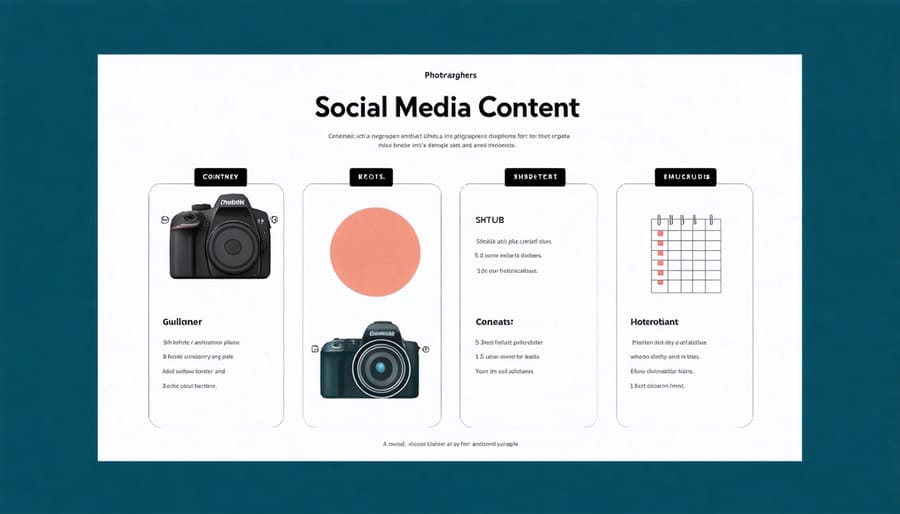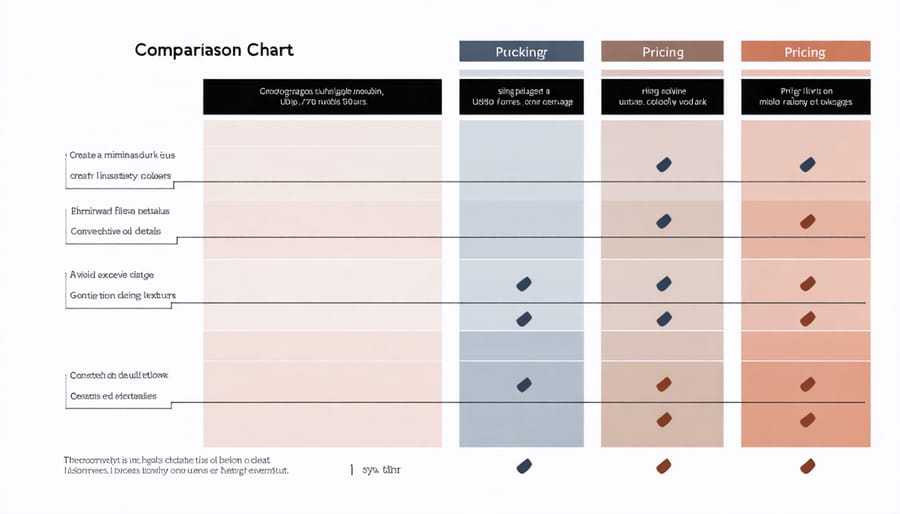
Transform your photography business with proven marketing strategies that distinguish your brand in today’s competitive market. Master social media storytelling by sharing behind-the-scenes glimpses of your creative process, showcasing your unique photography style, and engaging authentically with potential clients. Build a compelling online portfolio that captures your best work while implementing SEO best practices to attract your ideal clients. Leverage email marketing to nurture relationships with past clients and prospects, sharing exclusive offers and photography tips that keep your brand top-of-mind.
In an industry where visual impact meets business acumen, successful photographers must balance artistic excellence with strategic marketing. Whether you’re an established studio owner or an emerging professional, your marketing approach needs to be as carefully crafted as your images. From targeted local SEO to collaborative partnerships with complementary businesses, every marketing decision shapes your photography brand’s trajectory and client acquisition success.
Building Your Brand Identity

Define Your Photography Niche
In today’s competitive photography market, success often hinges on finding and dominating your specific niche. Rather than trying to be everything to everyone, focusing on a particular specialization allows you to build expertise, establish a unique brand identity, and attract your ideal clients.
Start by assessing your passions and strengths. Are you drawn to the raw emotions of wedding photography, the precision of architectural shots, or perhaps the creative freedom of fashion photography? Your genuine interest in a subject will shine through in your work and marketing efforts.
Consider also the market demand and competition in your area. Research local photography businesses, identify gaps in the market, and analyze which specialties have the potential for sustainable growth. For instance, if your region has numerous wedding photographers but few specialized in newborn photography, this could represent an opportunity.
Your target market should align with both your chosen niche and your business goals. Think about demographics, income levels, and lifestyle factors. A corporate headshot photographer might target local businesses and professionals, while a family photographer would focus on middle-income suburbs with young families.
Remember that your niche can evolve over time. Start specific – perhaps focusing on maternity photography – and gradually expand into related areas like newborn and family photography as you build your reputation and client base. This focused approach helps you develop expertise, streamline your marketing efforts, and command premium pricing in your chosen specialty.
Create a Memorable Visual Style
In today’s visual-first world, your photography brand needs to stand out while maintaining consistency across all platforms. Start by developing a cohesive color palette that reflects your photography style – whether that’s warm earth tones for nature photographers or bold, modern colors for commercial work. This palette should appear consistently in your logo, website, social media templates, and marketing materials.
Your portfolio presentation is crucial in helping transform your photography business into a memorable brand. Create a signature editing style that becomes instantly recognizable – think of how top photographers are known for their distinct visual approaches. Whether it’s your use of light, composition, or post-processing techniques, consistency is key.
Design a professional logo that’s versatile enough to work across different mediums, from watermarks on your images to business cards and social media profiles. Keep it simple and memorable rather than complex and overwhelming. Consider working with a professional designer if graphic design isn’t your strength.
Your website should mirror this visual identity, with a clean, intuitive layout that puts your images front and center. Choose a consistent font pairing – typically one decorative font for headlines and a clean, readable font for body text. Remember, your visual branding should tell your story before clients even read a word about your services.
Digital Marketing Essentials
Website Optimization
Your photography website serves as your digital storefront, making portfolio website optimization crucial for attracting and converting potential clients. Start by selecting a clean, responsive website template that loads quickly and showcases your images beautifully across all devices. Remember, potential clients often make snap judgments within seconds of landing on your site.
Organize your portfolio into clear categories and limit each gallery to 15-20 of your absolute best images. Quality trumps quantity every time. Include an easily accessible contact form and ensure your pricing packages (if public) are clear and well-presented.
For SEO basics, begin with proper image optimization. Name your image files descriptively (e.g., “beach-wedding-photography-miami.jpg” rather than “IMG_0123.jpg”) and always include relevant alt text. Create location-specific landing pages if you serve multiple areas, and regularly update your blog with fresh, keyword-rich content about your photography services and expertise.
Focus on creating compelling meta descriptions and title tags for each page, incorporating your target keywords naturally. Consider your potential clients’ search intent – what problems are they trying to solve? Address these in your website copy while maintaining a warm, professional tone.
Most importantly, ensure your contact information is visible on every page and include clear calls-to-action throughout your site. Your goal is to make it as easy as possible for potential clients to reach out and book your services.

Social Media Strategy
A strategic social media presence is essential for modern photographers, and success starts with choosing the right social media platforms for photographers. While Instagram remains the cornerstone platform for visual artists, don’t limit yourself to just one channel. Consider maintaining an active presence on Pinterest for wedding and event photography, LinkedIn for corporate clients, and Facebook for community engagement and local business networking.
Content planning is crucial for maintaining consistency and engagement. Create a content calendar that balances different types of posts: behind-the-scenes glimpses of your work process, finished portfolio pieces, client testimonials, and educational content that showcases your expertise. Aim to post at least 3-4 times per week, focusing on quality over quantity.
Remember to adapt your content for each platform’s unique characteristics. Instagram Stories work well for casual, day-to-day updates, while your main feed should feature your best work. Use relevant hashtags strategically, but avoid overdoing it – stick to 5-10 meaningful tags per post.
Engagement is a two-way street. Dedicate time daily to responding to comments, participating in photography communities, and connecting with potential clients. Consider using scheduling tools like Later or Hootsuite to maintain consistent posting while focusing on real-time engagement with your audience.

Email Marketing
Email marketing remains one of the most effective ways to nurture relationships with your photography clients and maintain a steady stream of bookings. Start by building your email list organically through your website, social media, and in-person interactions. Offer something valuable in exchange for email addresses, such as a free guide on “How to Prepare for Your Photo Session” or “Top 10 Location Ideas for Family Photos.”
Segment your email list based on client types – wedding clients, family portrait customers, commercial clients – to deliver more targeted and relevant content. This personalization helps improve engagement rates and keeps your messages from feeling generic.
Create a mix of email content types: promotional offers for repeat bookings, behind-the-scenes glimpses of your work, client spotlights, seasonal mini-session announcements, and photography tips. Aim to maintain a ratio of 80% valuable content to 20% promotional material.
Set up automated email sequences for different client journeys. For example, create a welcome series for new subscribers, post-session follow-ups, and anniversary reminders for past clients. These automated touchpoints keep you connected without requiring constant manual effort.
Remember to optimize your emails for mobile viewing, as most people check their email on phones. Use compelling subject lines, include clear calls-to-action, and always showcase your best images while keeping file sizes manageable to ensure quick loading times.
Client Acquisition Tactics
Referral Programs
Word of mouth remains one of the most powerful marketing tools in photography, and a well-structured referral program can significantly boost your client base. Start by creating an incentive system that rewards existing clients for bringing in new business. Consider offering a combination of discounts on future sessions, complimentary prints, or digital images for successful referrals.
Make the referral process as seamless as possible for your clients. Create professional-looking referral cards they can hand out to friends and family, or set up a digital referral system using unique codes that clients can share via email or social media. Remember to track these referrals meticulously to ensure proper attribution and reward distribution.
Timing is crucial when asking for referrals. The best moment is usually right after delivering their photos, when clients are most excited about their images. Follow up with a friendly email thanking them for their business and introducing your referral program.
Consider implementing a tiered reward system where clients can earn increasingly valuable benefits for multiple referrals. For example, three successful referrals might earn them a free mini-session, while five could result in a full photo session.
Don’t forget to express genuine appreciation for referrals. A handwritten thank-you note or small surprise gift can go a long way in encouraging continued advocacy for your business. Remember, satisfied clients who feel valued are more likely to become enthusiastic ambassadors for your brand.
Strategic Partnerships
Strategic partnerships can be a game-changer for your photography business, creating win-win situations that expand your reach and bring in new clients. Consider collaborating with wedding planners, event venues, local boutiques, and other businesses that complement your services without directly competing with them.
For wedding photographers, building relationships with bridal shops, florists, and makeup artists can create a powerful referral network. Each partner can recommend your services to their clients, effectively multiplying your marketing efforts. Consider offering partner-exclusive packages or special rates to strengthen these relationships.
Real estate photographers can benefit from partnerships with real estate agencies, interior designers, and home staging companies. These relationships often lead to steady work and reliable income streams. Similarly, portrait photographers might find value in partnering with local schools, dance studios, or modeling agencies.
To establish successful partnerships:
– Research potential partners whose client base aligns with your target market
– Prepare a clear proposal outlining mutual benefits
– Create co-branded marketing materials
– Offer partner-specific discounts or packages
– Maintain regular communication with partners
– Share testimonials and success stories
Remember to formalize partnerships with written agreements that clearly outline expectations, referral fees (if any), and terms of collaboration. Regularly evaluate the effectiveness of each partnership and be prepared to adjust or end relationships that aren’t delivering value for both parties.
Local Marketing
While digital marketing is essential, local marketing can create powerful connections within your community. Start by joining your local chamber of commerce and attending networking events where you can meet potential clients and fellow business owners. Bring your business cards and a small portfolio of your best work to showcase your style.
Consider partnering with local businesses that complement your services. Wedding venues, event planners, real estate agents, and even local boutiques can become valuable allies. Offer to cross-promote their services while they recommend yours to their clients. You might even create special package deals for mutual customers.
Community involvement is another effective strategy. Volunteer your photography services for local charity events or sponsor youth sports teams. This not only helps build goodwill but also increases your visibility among potential clients. Consider hosting photography workshops or free mini-sessions during community events to demonstrate your expertise and connect with prospective customers.
Traditional advertising methods still work well locally. Place eye-catching displays in coffee shops, libraries, and other community spaces. Local newspapers and magazines often have reasonable advertising rates and reach engaged local audiences. Don’t forget about neighborhood magazines and community bulletins – these publications often have loyal readership among your target market.
Remember to leverage word-of-mouth marketing by encouraging satisfied clients to refer friends and family. Consider implementing a referral program that offers incentives for successful recommendations.
Pricing and Packaging
Value-Based Pricing
Value-based pricing is a game-changer in photography business, moving beyond the traditional cost-plus model to focus on the actual value you deliver to clients. Instead of simply calculating your time and expenses, this approach considers the full worth of your photography services to different client segments.
Start by identifying your unique value propositions. What makes your photography special? Perhaps it’s your distinct artistic style, quick turnaround time, or exceptional client experience. These elements contribute to your pricing structure’s foundation.
Create tiered packages that cater to different client needs and budgets. For example, a wedding photography package might include:
Bronze: 6 hours coverage, digital gallery
Silver: 8 hours coverage, digital gallery, engagement session
Gold: Full-day coverage, digital gallery, engagement session, premium album
Each tier should offer clear additional value, making it easy for clients to understand why higher-priced packages cost more. Remember to consider your target market’s purchasing power and preferences when setting these tiers.
Factor in intangible benefits like your expertise, reputation, and the emotional value of preserving important moments. A family photographer with ten years of experience working with children can justify higher rates than a newcomer, based on their proven ability to capture perfect moments with unpredictable subjects.
Don’t forget to regularly review and adjust your pricing structure based on market feedback and your growing expertise. As your portfolio expands and your reputation strengthens, your value to clients increases, warranting appropriate price adjustments.
Finally, communicate your value clearly to prospects. Share client testimonials, before-and-after examples, and behind-the-scenes insights to demonstrate why your services command their price point.
Service Bundles
Creating attractive service bundles is a powerful way to increase your photography business’s revenue while providing excellent value to your clients. Start by analyzing your most popular services and identifying natural combinations that make sense for different client needs.
Consider creating three distinct tiers of packages: basic, premium, and luxury. Your basic package might include a one-hour photo session with 10-15 edited images, perfect for clients seeking headshots or simple family portraits. The premium package could extend to a two-hour session with 25-30 edited images, multiple outfit changes, and a mix of indoor and outdoor locations. Your luxury package might feature a full-day shoot, 50+ edited images, professional hair and makeup services, and premium printed products.
Remember to name your packages creatively but clearly. Instead of “Basic Package,” try something like “Essential Collection” or “Signature Session.” This subtle shift in language can enhance perceived value without changing the offering itself.
When structuring your bundles, include a mix of high-value, low-cost items to enhance perceived value. For example, adding a complimentary mini photo album to your middle-tier package costs you relatively little but can significantly boost the package’s appeal. Additionally, consider seasonal or special occasion bundles, such as holiday mini-sessions or graduation packages.
Always clearly outline what’s included in each package, avoiding hidden fees or unclear terms. Consider offering package add-ons or à la carte options for clients who want to customize their experience. This flexibility can help you capture sales from clients who might otherwise hesitate to commit to a pre-designed package.

As we’ve explored throughout this guide, successful photography marketing requires a multi-faceted approach that combines both digital and traditional strategies. The key is to start with a strong brand foundation and gradually build your presence across multiple channels. Remember that social media platforms like Instagram and Pinterest are particularly powerful for photographers, but they shouldn’t be your only focus.
Begin by implementing one or two strategies that align best with your photography style and target audience. Whether that’s optimizing your website for local SEO, creating engaging social media content, or networking at local events, it’s better to excel at a few approaches than to spread yourself too thin.
Don’t forget the importance of building genuine relationships with your clients and fellow photographers. Word-of-mouth marketing remains one of the most effective tools in the photography industry, and authentic connections lead to lasting business relationships.
Moving forward, set clear marketing goals and track your results. Use analytics tools to measure the success of your digital campaigns, and don’t be afraid to adjust your strategy based on what the data tells you. Remember that marketing is an ongoing process, not a one-time effort.
Take action today by choosing your primary marketing channels and creating a content calendar. Start small, stay consistent, and gradually expand your marketing efforts as you gain confidence and see results.























